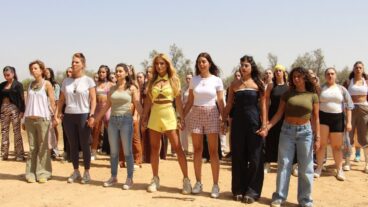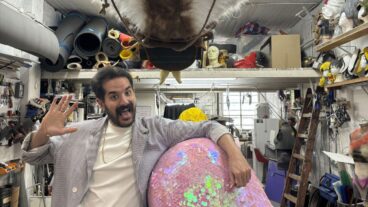Grafitti work by Nir Aharon, whose work is influenced by Basquiat, pop art, Andy Warhol, Roy Liechtenstein and Keith Haring among others”Kilroy” “Marry Me Melanie!” “Luke Was Here” “Crips” “Bloods” “Bin Laden or Bust”.
Whether it’s called tagging, hieroglyphics, muraling, or public art, graffiti has been around since the days of ancient Egypt. According to the artists who have made it their calling, it is the oldest known form of visual expression.
In New York City, graffiti has now come off of the streets and into the mainstream art world this month as artists join forces across cultural divides to present Beyond Graffiti: Fresh Visions from Tel Aviv, Jerusalem and New York City.
Hosted by the Bronfman Center Gallery and curated by Lois Stavsky, the exhibit celebrates a constantly evolving street art form that has moved from Old School spray paint and markers towards more sophisticated mediums like stencils, stickers, canvass, oil, graphics and fine art.
“I’ve always loved graffiti,” admits Stavsky, a public educator who first noticed the art form on her students’ notebooks in the early 80’s. Her initial impression of the art form was that “it seemed like a spontaneous expression of often stifled creative spirit.”
A graffiti curator in Manhattan’s Lower East side for several years, Stavsky upon meeting Bronfman Center coordinator Jackie Miller, mentioned her background, and Miller suggested she curate an exhibit of NYC and Israeli artists.
“I was thrilled to have the opportunity – more like an ‘excuse’! – to research the street art scene in Israel,” Stavsky told ISRAEL21c.
What Stavsky found in Israel was a mix and match of artists and “hauntingly beautiful” stencils in the streets of Jerusalem and in Tel Aviv’s Florentine neighborhood that she’d never seen in New York. She also noted that Israelis are less advanced than US and European taggers when it comes to wild-style lettering. “But that may just not be a Middle Eastern thing,” she concedes.
The word graffiti derives from the Latin graphium meaning to write with a stylus. An art form generally introduced into the public realm undercover, in secrecy and under time constraints, it is often a vehicle for messages of a political, cultural or a very personal nature.
Graffiti’s relationship with Israel can be traced back thousands of years to Egyptian hieroglyphics, Hamorabi writings on a 2nd Century B.C. grave, scripts scratched into Masada walls and writings etched on the walls of Jerusalem’s Holy Sepulcher Church.
In the here and now, Israel’s graffiti is an eclectic mix of increasing high tech influences, local tagging and expressions of religious and political opinion.
“One piece in Jerusalem centered around the movie Twelve Monkeys,” explains graffiti artist, blogger, activist and hip hop DJ Dan “Mobius” Sieradski. “But instead it used 120 Monkeys. What does a piece like that say? That whatever goes on in the Knesset or whoever gets into office, it’s all monkey business at the end of the day.”
A 26-year-old New Yorker, Sieradski came to Israel in 2004 on a future leader fellowship and decided to stay. As part of his fellowship commitment he started Corner Prophets, a non-profit organization centered on hip hop music and organizing joint Israeli/Palestinian, Ethiopian and Russian immigrant rapper concerts.
A graffiti purist who prefers illegally displayed public art over gallery hangings, Siedarsky helped organize the upcoming Bronfman exhibit and will be showing his work there as well. “Street art is defiant; it’s not for people who can afford tickets. It’s for the people, it puts art back in the people’s hands and it’s an expression of collective wills and desires. And it has influenced modern art. Like Basquiat whose roots were in street art and graffiti and then moved to the fine arts,” he told ISRAEL21c.
Jean-Michel Basquiat’s name, synonymous with the origins of modern graffiti, also pops up when speaking with Tel Aviv graffiti artist Nir Aharon. A self described “child from the slums of Beersheva”, Aharon counts Basquiat, pop art, Andy Warhol, Roy Liechtenstein and Keith Haring among chief influences upon his work. Aharon’s art has been shown widely in Israeli museums as well as in Chicago, Tel Aviv, Miami, Barcelona and now New York.
Aharon’s graffiti is a by-product of youthful rebelliousness. “I started with graffiti or street art in high school. My first major project was when I was 16 and my high school gang and I sabotaged the school with graffiti protesting the school and our teachers. There was a criminal investigation and the police came and everything. They didn’t catch us, though, and there was an article in the local paper. So we got artistic exposure on top of it all,” Aharon recalls with glee.
Now a successful graphic designer and art director for interactive television, his Bronfman pieces reflect his exposure to marketing. “These pieces are what I call my ‘cans’ or ‘product lifecycle model’. I show shiny new sparkly cans that get banged up, and rusty and go to the garbage can and then get fixed up again and are brought back to life and made worthwhile. It’s a statement about life in general,” he explains.
So where is the graffiti in these oil-on-canvas works? “In the margins. I scribble marketing slogans all around the margins,” says Aharon.
New York artist Denise Carbonell is not Israeli but she has traveled extensively through Israel and is familiar with the Middle Eastern symbolism of the open hand. Her linoleum, glass and wood hands scrawled with words of inspiration will be co-exhibited alongside the canvass, mural and other graffiti pieces.
“I’m honored to be included in this exhibit. The hand has always signified peace and an opening of the spirit to everything and everyone around us; this one image speaks to people in an infinite amount of ways,” Carbonell said of her work.
Beyond Graffiti: Fresh Visions from Tel Aviv, Jerusalem and New York City opened at the Bronfman Center Gallery (7 East 10th Street between 5th Avenue and University Place) on March 30 and continues through May 5. Workshops and interactive presentations will be offered in connection with the exhibit.












